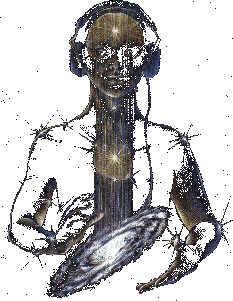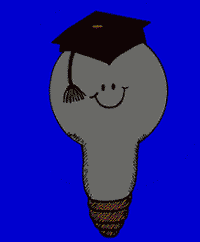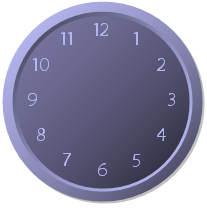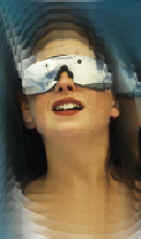|
||||
What is the function of the various brainwaves? A man named Caton first discovered electrical rhythms within
the brains of animals in 1875. It was over 50 years later when Hans
Berger showed that man also had these rhythms. His original search
was in the hopes of finding the physical link between man's mind and
his body.
Animation courtesy of Dr. Dan Russell,
Kettering University
The raw EEG has usually been described in terms of frequency bands: Gamma greater than 30(Hz) BETA (13-30Hz), ALPHA (8-12 Hz), THETA (4-8 Hz), and DELTA(less than 4 Hz).
What
is the function of the various brainwaves?
Amplitude represents the power of electrical impulses generated by the brain. Volume or intensity of brain wave activity is measured in microvolts. "Gentlemen,
I have a confession to make - half of what we have taught you
is in error;
and furthermore we cannot tell you which half it is." The next brainwave category in order of frequency is alpha. Where beta represented arousal, alpha represents non-arousal. Alpha brainwaves are slower, and higher in amplitude. Their frequency ranges from 9 to 14 cycles per second. A person who has completed a task and sits down to rest is often in an Alpha state. A person who takes time out to reflect or meditate is usually in an Alpha state. A person who takes a break from a conference and walks in the garden is often in an Alpha state.
One of the main purposes for sleep is to transfer information and experiences from short to long-term memory. Concentration, learning and recall ability can and is greatly enhanced with alpha-theta control systems. Recall capability is greatest in alpha state. Also, by learning to exclude all external stimuli when trying to achieve the alpha-theta control, increases one's ability to concentrate.
This state is traditionally labeled unconscious by western medicine. In recent years, however, people trained with light and sound tools and biofeed back can achieve this state and retain consciousness, similar to meditators. Theta has come to be associated with such things as hypnogogic imagery, day dreaming, sleep, and creativity. It has also been shown as the state where healing and regenerating of tissue occurs. |
||||
nimation courtesy of Dr. Dan Russell, Kettering
University |
||||
Theta rests directly on the threshold of your subconscious. In biofeedback, it is most commonly associated with the deepest levels of meditation. Theta also plays an important part in behavior modification programs and has been used in the treatment of drug and alcohol addiction. Finally, Theta is an ideal state for super-learning, re-programming your mind, dream recall, and self-hypnosis.
|
||||
Theta waves range between 4-8 HZ. Theta is one of the more elusive and extraordinary realms we can explore. It is also known as the twilight state which we normally only experience fleetingly as we rise up out of the depths of delta upon waking, or drifting off to sleep. In Theta, we are in a waking dream, vivid imagery flashes before the mind's eye and we are receptive to information beyond our normal conscious awareness. Theta has also been identified as the gateway to learning and memory. Theta meditation increases creativity, enhances learning, reduces stress and awakens intuition and other extrasensory perception skills. |
||||
The Shamanic State of Consciousness, which is theta brainwaves,
allows a journey into the higher planes. The steady-rhythmic beat of
the drum struck four and one-half times per second (theta waves are
4-7 cps) is the key to transporting a shaman into the deepest part
of his or her Shamanic trance. The constant and rhythmic-drone of Tibetan
Buddhist chants that transport the monks and other listeners into realms
of blissful meditation also follow this rhythm. The EEG (electroencephalograph) measures brainwaves of different frequencies within the brain. Electrodes are placed on specific sites on the scalp to detect and record the electrical impulses within the brain
|
||||
The cerebral cortex is the outermost part of the brain. It is this convoluting mass of tissue that gives man superior intelligence. The cortex of each hemisphere is divided into four main areas, called lobes. Alpha is found predominantly on the occipital lobe or back-part of the brain. This is the section which deals with visual systems. Alpha is also found in the frontal lobe, but not as easily. Theta is found more commonly on the temporal lobe, while the speech, sensory, and motor areas tend to show primarily beta activity.
Alpha-theta neurotherapy has demonstrated what the research team of Elmer and Alyce Green and Dale Walters at The Menninger Foundation said in the 1970s: Causing the brain to generate theta activity daily over a period of time seems to have enormous benefits, including boosting the immune system, enhancing creativity, and triggering or facilitating "integrative experiences leading to feelings of psychological well-being." The protocol seems to transcend the patient's lack of motivation to change, initial incapacity to create internal visual imagery, and/or disbelief in the effectiveness of the treatment. Frequently a patient's experience and results far exceed the goals targeted (in the visual imagery). |
||||
The reverie state which is indicated by theta and low-frequency alpha seems to increase hypnagogic and dream-like images. There is also a link between reverie and hypnagogic imagery and creativity. These images are critical for the creative process. Scientists are learning more about how theta states can be summoned and harnessed to create mindstates that are conducive to expanded states of consciousness. Great ideas occur during this time period. Einstein came up with the theory of relativity in this state, and likewise, one of the Watson and Crick pair visualized the double helix in this mindstate successfully cracking the illusive architecture of DNA.
By merging both hemispheres of the brain, and allowing them to work together you can increase mental fitness (like having a faster modem working at faster speeds). A more integrated system creates better performance. Edgar Cayce, a famous clairvoyant healer was found to have an unusually large corpus callosum
The Theta state is where intuition comes, instantaneous healings occur and accelerated learning occurs. Einstein trained himself to spend many hours in that state. It is where you feel one with All.
|
||||
When we go to bed and read for
a few minutes before attempting sleep, we are likely to be in low beta.
When we put the book down, turn off the lights and close our eyes,
our brainwaves will descend from beta, to alpha, to theta and finally,
when we fall asleep, to delta.
Research has shown that although one brainwave state may predominate at any given time, depending on the activity level of the individual, the remaining three brain states are present in the mix of brainwaves at all times. In other words, while somebody is an aroused state and exhibiting a beta brainwave pattern, there also exists in that person's brain a component of alpha, theta and delta, even though these may be present only at the trace level. |
||||
DELTA brainwaves are your unconscious mind, the sleep state, but when present in combination with other waves in a waking state, Delta acts as a form of radar – seeking out information – reaching out to understand on the deepest unconscious level things that we can't understand through thought process. Delta provides intuition, empathetic attunement, and instinctual insight." "Someone in an Awakened Mind state (specific activation of beta, alpha, theta and delta in both hemispheres) has access to the unconscious empathy, intuition, and radar of the delta waves, the subconscious creative storehouse, inspiration and spiritual connection of the theta waves, the bridging capacity, lucidity and vividness of imagery, and relaxed detached awareness of the alpha waves, and the ability to consciously process thoughts in beta – all at the same time!"
After the development of the EEG, scientists Adrian and Matthews discovered that repetitive light and sound frequencies were a stimulus to which brain wave activity would react and respond. Various psychologist and researchers used this information for brain wave synchronization (BWS) experiments and therapies. A noticeable and outstanding result was the ability to self-direct deep levels of relaxation and focused states of hypnosis. About 1940, physiologist William Grey Walter discovered that at certain entrainment frequencies, his subjects would enter trance-like states, where they began to experience deep peacefulness, dream-like visions, and other unexpected sensations. In 1958, the first brain wave synchronizer (BWS) was introduced commercially by Sidney A Schneider. Today BWS is more popularly called a mind machine or a light and sound device. |











